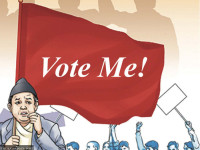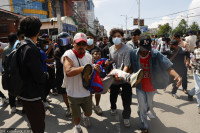Editorial
A two-way street
Maintaining road discipline and ensuring road safety will bear less fruit if the government or motorists fail to do their part..jpg&w=900&height=601)
Collective moral behaviour and civic sense are important for societies to evolve. But the government must do its part too if it wants its citizens to live freely and safely. In its effort to maintain lane discipline, the Metropolitan Traffic Police Division decided to up its game. But thanks to the absence of lane markings on most road sections, the drive is yet to be effective.
Bad road etiquette and poor infrastructure both are to be blamed for the lack of order on the roads. Infrastructure such as zebra crossings, overhead bridges, sidewalks and so on are few and far between. Therefore, pedestrians are often forced to cross the road wherever they can. As it is, with 60 percent of the zebra crossings in the Kathmandu Valley lying discoloured for years, pedestrians crossing the road are putting their lives on the line.
According to the division office, around 200 people are booked every day for violating lane discipline in Kathmandu. To ensure road safety, the division has also notably increased the number of traffic police personnel on the roads who specifically keep a check on lane violations. Of the total 1,400 officers designated to manage the traffic in Kathmandu, 20 percent are deployed for enforcing lane discipline. While this is a commendable effort, it should equally focus on making sure the roads are marked properly.
Once this is done, the motorists, on their part, need to follow the rules and not change lanes haphazardly or drive on the wrong lane. Many motorists often break the prescribed speed limit, overtake other vehicles on the wrong side, and nonchalantly cruise on the wrong side on highways and expressways. Pedestrians too contribute substantially to the chaos on Kathmandu's roads. Most people walk and cross the road anytime and anywhere with impunity.
Road markings are the least understood and followed concept in Nepal. No doubt, it has become a major lapse in road safety. But it is important to understand that road safety is a double-sided and complimentary exercise. Around 40 percent of road accidents happen due to the poor state of road crossings, traffic police data shows. Maintaining road discipline and ensuring road safety will bear less fruit if the government or the motorist fail to do their part.
According to a government report, the Nepal Road Safety Action Plan (2013-20), Nepal has one of the highest road fatality rates. A report published in February 2018 says around 2,000 people die every year in road accidents in Nepal. To bring a lasting solution to this problem, the traffic police must first ensure there are enough road infrastructures, like working traffic signals and properly marked lanes and zebra crossings. And if motorists still do not adhere to the rules, confiscating their licence, imposing a hefty fine and threatening violators with worse if they attempt to bribe the cops should be done. Lack of fear of the law or its enforcers has become a huge problem for road safety. The traffic police should thus lead by example.
What do you think?
Dear reader, we’d like to hear from you. We regularly publish letters to the editor on contemporary issues or direct responses to something the Post has recently published. Please send your letters to [email protected] with "Letter to the Editor" in the subject line. Please include your name, location, and a contact address so one of our editors can reach out to you.




 10.12°C Kathmandu
10.12°C Kathmandu














